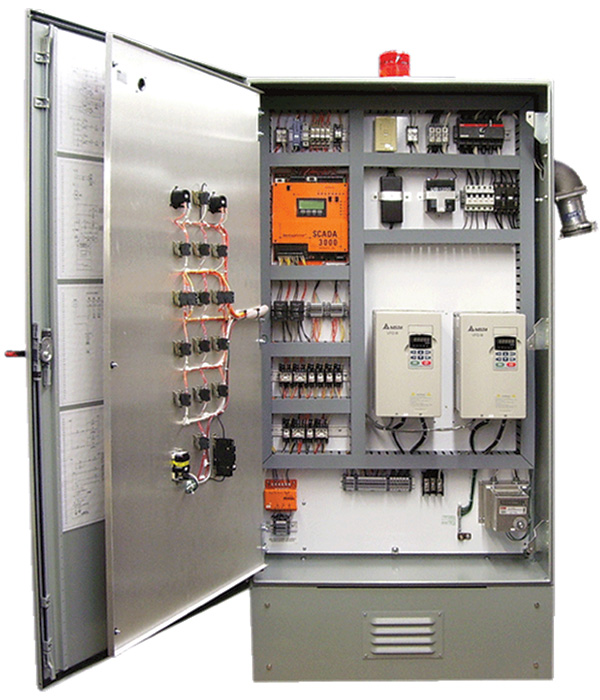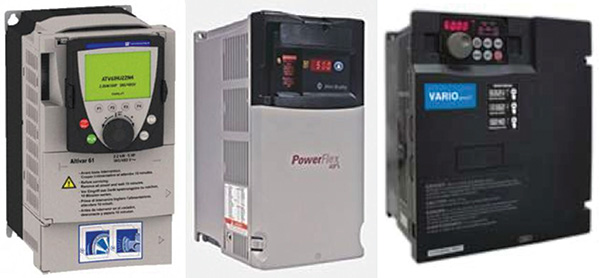Pumps & Systems, July 2013
Pump system controls have a long and evolved history. An examination of the industry reveals water transportation as the ultimate goal. Whether transporting freshwater or wastewater, all the hardware, technology and engineering has one outcome: moving water from one location to another.
Water is moved for many reasons, including:
- Treatment to clean, filter, cool, heat, aerate or purify for use or consumption
- Use it as a transfer medium tool of kinetic energy to generate hydroelectric power and/or to pressure clean items
- Use it as a transport medium (for example, logging, pressure sewage, machined filings)
History of Pump System Controls
The discovery that man and mules could be replaced with steam, gas and diesel engines and, ultimately, electric motors began the electric age, which led to present-day pump control, automation and instrumentation.
Control of pump systems was accomplished with a simple, electromechanical pressure switch. These pressure control switches were—as are most electrical controls—a mechanical device designed to perform an electrical function. The switch was a hardware spring mechanism that sensed and reacted to pressure bellows to open or close electrical contacts in relation to water pressure in a closed pump system. These contacts were then used to activate or deactivate an electric-motor-driven pump and are still the most commonly used pump control device.
This simple control of the functionality of an electric pump then led to the development of multiple-system pump control devices—such as alternators, water sensors, seal leak detectors, intrinsically safe relays and a myriad of level control and detection devices. These devices may be mechanical, electromechanical, electronic/solid-state and integrated circuits, which execute a limitless number of functions.
In standard pump control systems, these devices are used as control functions to carry out the operating sequence and functionality of a pump system. A standard control panel would use electromechanical relays and contactors to define the control sequence per the electrical schematic design and via the physical wiring of the control components.
A modern custom control panel with PLC, VFDs and SCADA
Programmable Logic Controllers
The present state of technology for system sensors and monitoring devices allows for information gathering of any aspect of a water system. Using mechanical, electromechanical, solid-state, load-cell, transducer, capacitive, sonic, radar or radio frequency (RF) technology, many metrics can be monitored—including liquid level, pressure, temperature, flow, pH, turbidity, dissolved oxygen, torque, kilowatts, power factor, density and weight.
Automation controls, specifically programmable logic controllers (PLCs), have expanded and streamlined electrical control. Originally designed to alleviate automotive industry model-year manufacturing changeover-time delays and expenses, PLCs have filled a niche in controls technology. PLCs provide a way to use and monitor the system sensors that are available as input devices. They then use real-world information gathered from the input devices to perform a function based on a specifically designed, internal system “user” program. The user program then makes decisions based on the currently available real-world data from the inputs and activates or deactivates output devices—such as contactors, starters, lights and alarms.
Because PLCs are solid-state automation systems, they can receive or send digital (on/off) and/or analog (0 to 10 volts direct current or 4 to 20 milliamperes) signals, making them perfect for monitoring any analog sensing input device. Since a PLC is basically a computer processor designed to be a control system, it has the-in ability to communicate on multiple hardware and software platforms using:
• Modbus
• DeviceNet
• CAN
• Supervisory control and data acquisition (SCADA)
• ProfiBus
• DataHighway
• Remote I/O
• Ethernet
• Industrial Ethernet
The PLC’s inherent design has the ability to gather and report system operating data and performance information and display it via human machine interface (HMI) or operator terminal interface (OTI). These HMI terminals use a keypad or touchscreen and are available in multiple configurations and sizes. This system data can then be recorded in a database and transmitted in any configuration to provide system performance data, trending and alarms in multiple formats to remote locations.
PLCs continue to develop with another version that evolved from better processor hardware technology—the process automation controller (PAC). While the PLC requires a program scan time measured in milliseconds to perform a user program scan, the PAC can perform this function in microseconds. This makes PACs well-suited for high-speed control, safety and data processing applications as required by large municipal treatment plant and petrochemical process control applications.
With the growth of pump control technology, the pump motor industry is using multiple types of motors in the water/wastewater industry. This industry has always used shaded-pole, permanent-split-capacitor (psc), capacitor-run, split-phase and capacitor start-capacitor run motors in single-phase applications, and multiple styles of induction motors in three-phase applications. These are tried and true motor technologies that will continue to be used in the future.
PLCs can be used to control a limitless number of applications.
Variable Frequency Drives
The advent of variable frequency drive (VFD) technology has provided new control options for the pump industry. The development of insulated gate bipolar transistors (IGBTs), which are used in VFDs, enabled the high-current/high-speed switching of motor loads. The VFDs use IGBTs to employ pulse width modulation (PWM), which allows precise control of the speed of AC electric motors and, in turn, the speed of the pumps connected to those motors.
VFD technology allowed the pumping industry to match the hydraulic performance curve demands precisely without the need for trimming impellers or using bulky and cumbersome sheave/V-belt mechanical power transmission systems.
Current VFD technology has married the VFD with the PLC to potentially make it an all-in-one pump control system. These intelligent drive systems allow the VFD to monitor and control single or multiple pump applications. It can perform internal, multiple pump system alternation, monitor for hydraulic performance points and power (kilowatt hour) usage, and other pump control options. This allows the intelligent VFDs to monitor the motor/pump performance to provide the most efficient system operation. This power efficiency management is built into many control panels. These intelligent automation panels can calculate the best kilowatts/gallon power efficiency. The more gallons pumped with the least amount of kilowatts provides the best efficiency. This calculation is becoming important to provide cost savings for operators and to adhere to new Department of Energy pump efficiency recommendations.
VFDs are available from multiple manufacturers to fit any application.
Electric Motors in Municipal Sewage Treatment Plants
Electric motors that were previously only used in industrial manufacturing and machine tool applications are being used in different applications. Specifically, permanent magnet motors are being used in aeration systems for municipal sewage treatment plants. These permanent magnet motors perform the same function as any motor (convert electrical energy into mechanical energy). However, with their permanent magnet rotors, they do it at speeds of up to 65,000 rpm and are controlled by a servo-drive.
These turbine air pumps, using high operating speeds, run at a high efficiency, which creates great potential for electrical energy savings when compared to traditional technology, such as treatment lagoon circulation/aeration pumps.
Marriage of Technologies
The development of new water and wastewater technologies make the marriage of these technological advances a necessity. New water and wastewater technologies include pressure boosters, rainwater harvesting, reverse osmosis, membrane bioreactor, moving-bed bioreactor and ceramic filtration systems.
All types of sensors are used to monitor every aspect of a system. Then the calculation and control of any operating demands are carried out using a PLC or a PAC. The system’s performance is reported using an HMI, and VFDs control the pump/motor system to meet application demands.
Conclusion
An experienced pump professional in the industrial, commercial and pump control industry recently made an observation—if the frills and extravagances of the pump control industry are removed, the industry is performing the simple function of electric motor control. This means a pump is only turning on and off in an effort to transport water. Using every facet of modern technology with control, automation and instrumentation allows different—and hopefully smarter—ways to do move water from one location to another.
The technology exists to control, monitor, record, communicate and store in a database any function of a pumping system. As some of the automotive manufacturers learned in the 1990s in several modernization projects, a point arises in which control, monitoring and instrumentation becomes overkill and is no longer cost-effective. The technological capability exists to create that “overkill” scenario in the pump control industry. End users and operators should be cautious about the complexity of the systems that are designed and specified. Are the control and monitoring systems the most efficient and cost-effective way to control and operate the pump system for the given application? The question is no longer if monitoring and control can be accomplished. Instead, we need to question if it should be accomplished. Is massive automation necessary to the ultimate functionality of a system, and is it cost-effective? P&S

